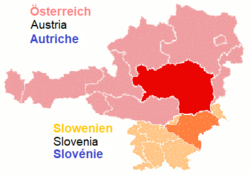Styria (Slovenia)
|
Styria (Slovenia) Spodnja Štajerska / Untersteiermark |
|
|---|---|
| Traditional region | |

Typical Lower Styrian landscape in Sevnica.
|
|
 Territory of the former Styrian duchy, superimposed on the modern borders of Austria and Slovenia |
|
| Country | Slovenia |
| Elevation | 300 m (1,000 ft) |
|
2b Inner, 2c Lower |
Styria (Slovene: Štajerska), also Slovenian Styria (Slovenska Štajerska) or Lower Styria (Spodnja Štajerska; German: Untersteiermark), is a traditional region in northeastern Slovenia, comprising the southern third of the former Duchy of Styria. The population of Styria in its historical boundaries amounts to around 705,000 inhabitants, or 34.5% of the population of Slovenia. The largest city is Maribor.
In the 19th century the Styrian duchy, which existed as a distinct political-administrative entity from 1180 to 1918, used to be divided into three traditional regions: Upper Styria (Obersteiermark; Zgornja Štajerska) and Central Styria (Mittelsteiermark; Srednja Štajerska), as well as Lower Styria, stretching from the Mur River and the Slovene Hills in the north down to the Sava. The first two parts, predominantly German-speaking, today form the Austrian state of Styria (Steiermark). The southern third, predominantly Slovene-speaking, is today part of Slovenia.
Although used interchangeably at times, the term "Southern Styria" (Südsteiermark) refers to the southern districts within the Austrian state of Styria, whereas the term "Lower Styria" (Spodnja Štajerska) refers to the northeastern region of Styria within Slovenia.
In the Middle Ages, the Lower Styrian lands were ruled by several immediate (reichsfrei) dynasties like the Counts of Celje, whose large possessions were not incorporated by the Habsburg dukes until the 15th century. The Austrian rulers had the estates developed benefitting the Lower Styrian towns and its predominantly German-Speaking citizens. According to the last Austro-Hungarian census of 1910, Lower Styria had around 498,000 inhabitants, of which around 82% were Slovene and around 18% German speakers.
...
Wikipedia

